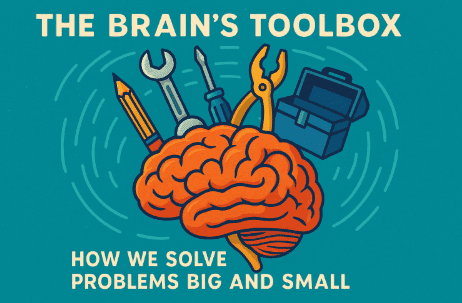
Recap Before We Begin 🔄
In Lesson 1, we learned how sparks between neurons build into thoughts.
We discovered that neurons fire in patterns, different brain areas add their own “instruments” to the orchestra, and attention acts like a spotlight to focus on certain patterns.
Finally, we saw how working memory holds a thought long enough to use it.
Now let’s take this a step further.
A thought is one thing, but solving a problem—that’s a much bigger challenge. How does the brain do it? Let’s explore the amazing toolbox inside your head.
What Is a Problem? 🤔
Before we see how the brain solves problems, let’s ask: what is a problem?
A problem is simply a gap between where you are and where you want to be. For example:
-
You’re hungry, but there’s no food ready. (Gap: hunger → solution: cook something).
-
You have math homework: “What is 34 + 57?” (Gap: question → solution: answer).
-
You want to invent a new game. (Gap: idea needed → solution: creativity).
So every problem is a “puzzle” where the brain has to move from “not knowing” to “finding the answer.”
The Brain’s First Tool: Trial and Error 🧪
The simplest way to solve a problem is trial and error. Imagine a baby trying to stack blocks. At first, the blocks fall. But after many tries, the baby figures out how to balance them.
In trial and error, the brain uses feedback.
Each time you try, neurons fire in patterns. If it doesn’t work, the brain adjusts.
If it does work, the brain strengthens those neuron connections. This strengthening process is called learning.
Think of it like finding your way in a dark room. You bump into things, adjust, and eventually learn where everything is.
The Brain’s Second Tool: Memory 🗂️
Memory is like the brain’s filing cabinet. When you face a problem, the brain searches old files to see if it has solved something similar before.
For example: If you’ve already learned that 5 + 5 = 10, then when you face 50 + 50, your brain can use that past memory to solve faster.
This is why practice is so powerful. The more files (memories) your brain has, the easier it becomes to solve new problems.
The Brain’s Third Tool: Logic 🔢
Logic is the brain’s step-by-step problem solver. It lives mainly in the frontal lobe.
For example:
-
If I know that all birds have wings…
-
And I know that a sparrow is a bird…
-
Then logically, a sparrow has wings.
Logic is slower than trial and error, but it is more reliable. Computers use pure logic to solve problems. Humans use it too—but we often mix it with memory and creativity.
The Brain’s Fourth Tool: Creativity 🎨
Not all problems can be solved by memory or logic. Sometimes you need creativity. Creativity means connecting ideas in new ways.
Imagine you need to invent a chair but you don’t have wood. You could use old tires, or even a pile of books. That’s creativity—seeing new connections.
Creativity often comes from the right hemisphere of the brain (the right side). It is also linked to the default mode network—the brain network that becomes active when you daydream or rest.
That’s why some of your best ideas come when you’re not trying hard, like in the shower or while walking.
The Brain’s Fifth Tool: Heuristics (Shortcuts) 🛣️
Heuristics are mental shortcuts. Instead of solving a problem step by step, the brain uses quick rules.
Example:
-
If you need to pick the fastest line at the grocery store, you don’t count each person’s items. Instead, you might just join the line with the fewest people. That’s a heuristic.
Heuristics save time but can cause mistakes. Sometimes the “shortest-looking line” actually moves slower. Still, without heuristics, we’d waste too much brainpower on small problems.
Conclusion 🌟
The brain has an amazing toolbox for solving problems: trial and error, memory, logic, creativity, and heuristics. Each has its strengths. Sometimes we need trial and error. Sometimes memory saves the day. Sometimes creativity brings a new idea. And often, we mix them all.
That’s how the brain can handle both small puzzles—like opening a jar—and giant challenges—like building rockets to the moon. 🚀